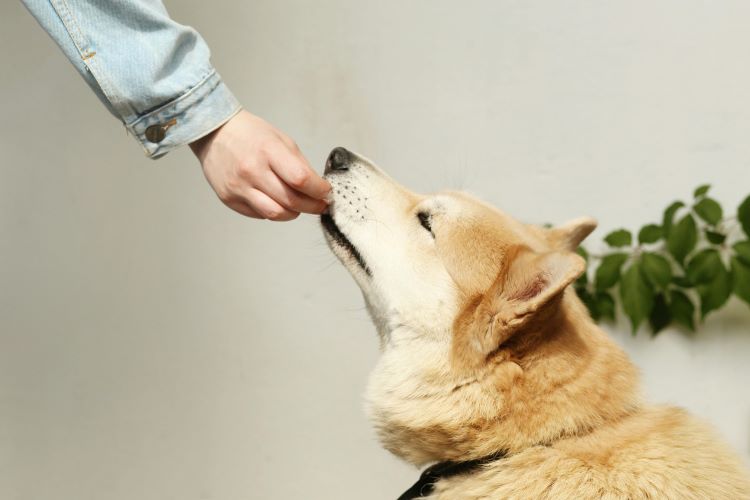Ready to help treat your pet to a healthy life?
The Top Misunderstood Dog Behaviors (According to Experts)
By : Brianna Gunter | Published Aug 1, 2024

Human relationships with dogs are, in simplest terms, something special. Dogs are the first known animals to have been domesticated, forming an ancient alliance that pre-dates agriculture. You’d think by now we’d understand our canine friends completely, in all aspects of their behavior.
Alas, real life isn’t quite so simple. Our relationship with dogs continues to evolve, along with our understanding of them (or sometimes lack thereof). Even the best pet owners may not realize what certain dog behaviors really mean. There are also times when we may respond to a canine reaction inappropriately and then wonder why our pup continues to act out.
But it doesn’t have to be this way. To learn more about these misunderstandings and how we can make improvements, we asked two experts on canine behavior and training for their insights.
The importance of understanding your dog
Misunderstandings can happen even with the strongest pet-person bonds. They happen in human relationships as well. But unlike people, our canine friends can’t verbalize when something is wrong or when we may be missing the point. Because of this, underlying problems may not get properly addressed.
“Understanding the reasons behind a dog's behaviors is essential to providing the best support," says Julie Forbes of Sensitive Dog in Seattle. "Behaviors are a form of communication, and we strive to understand why dogs are feeling what they are feeling so that we can help them effectively.”
A holistic dog behaviorist with 22 years of experience and a specialization in difficult canine behaviors, Forbes explains it’s important to get to the root of canine conduct rather than just responding to surface signs. Behaviors can look the same, but be motivated by different things like fear, frustration with the environment, or even an adrenaline response. Understanding the nature of a dog’s behavior helps us to understand how the dog needs to be supported and worked with to feel better, and therefore behave better.
The top misunderstood dog behaviors
All canine behaviors may be misinterpreted by pet owners from time to time, but some fall victim more often than others. While these can vary from case to case, common areas of confusion include:
Pain reactions
Are you always able to tell when your pup is hurting? Probably not, according to Erdman.
“When a dog is reacting towards something, it’s typically a result of discomfort, fear or frustration,” says Bravo Dog’s Renée Erdman, a Vancouver-based canine behavior consultant with over 12 years of experience. “Dogs that have reactive tendencies often have a pain and discomfort component that has gone unnoticed or undiagnosed.”
That’s right — misunderstanding a dog’s pain and discomfort doesn’t just result in a negative experience with the pet owner; it can cause health conditions to go undiagnosed. As one multi-institution report found, undiagnosed pain accounts for a whopping 30 to 80 percent of veterinary behavioral issues.
Stress and anxiety
Anxiety in dogs has gotten more attention in recent years, but there remains a lot of misunderstanding around both recognizing it and addressing it properly.
“Many people don't realize how to help their dogs effectively and may unintentionally reinforce anxious behaviors,” Forbes says. “Often, humans respond to their dogs' anxiety by talking to them in an anxious tone, saying things like 'It's okay, it's okay,' or by patting and petting them nervously. While we intend to comfort our dogs, these actions can actually reinforce their anxiety. The energy and anxiety behind these actions signal to the dog that there is something wrong and something to be afraid of, creating a feedback loop of anxiety between the dog and owner.”
Forbes explains that the best way to help an anxious dog is to stay calm and grounded yourself. Dogs are attuned to their owners’ emotions, so the best thing we can do is to be an example of how we want them to feel.
“Dogs need comfort, but it's crucial to understand how to provide it appropriately so that the dog feels confident and secure rather than anxious and insecure,” she says. “Anxiety in dogs is a complex issue, and each dog is unique. At Sensitive Dog, we approach this challenge through a holistic lens, considering factors such as genetics, history, health, diet, exercise (both physical and mental), human interactions, family dynamics, and environment. Dogs respond best when all aspects of their well-being are supported.”
Showing their belly
Dogs love belly rubs, right? Not always, according to Erdman. Context matters.
“For some dogs this is not an invitation to rub their belly, and their body language will show a very stiff body, a tightly closed mouth, ears pinned backward, the whites of their eyes showing and a tucked tail,” she says. “This is a dog asking for space and sadly so often misunderstood.”
Growling
As Erdman notes, society views a dog growling as “rude” and “unacceptable” behavior that should not be tolerated or viewed positively. However, the reality is that it is an integral communication tool for our canine friends that sadly goes misunderstood.
“This low level warning is indicating that the dog is uncomfortable and when humans get upset or angry, we are pushing dogs to bite and not warn,” Erdman says. “I often tell my clients that a dog that growls is a great communicator and that we should be grateful for this. If we don’t want our dogs to growl, we must address the underlying issues that are resulting in our dog’s discomfort and help them.”

Pet owner mistakes with handling dog behavior
When unwanted canine behavior becomes a pattern, it’s often the result of the pet owner not responding properly in the first place. This is especially true when people accidentally reinforce certain behaviors, like acting anxiously, by giving positive, coddling attention when it’s not appropriate.
“When praising or rewarding your dog, focus on the specific task or behavior you want them to perform, especially in challenging situations,” Forbes says. “This approach helps your dog understand how to respond when they feel activated, encourages them to think and engage, reinforces desirable behaviors, builds their confidence, and prevents the accidental reinforcement of undesirable states we aim to correct.”
Considering how dogs naturally communicate with each other, Forbes also emphasizes the importance of clear expectations and healthy boundaries.
“Dogs thrive when they know what is expected of them and when boundaries are consistently maintained,” she says. “Observing dogs that are excellent at communicating with their peers reveals that they are clear, direct, and consistent in their interactions and expectations. Modeling our communication with dogs after these principles leads to more effective and harmonious relationships.”
At the same time, too much punishment or suppressing canine behavior can be its own problem. Reacting too strongly in response to your pet’s behavior can cause important underlying issues to go unnoticed.
“Punishment may not be overtly abusive, but it aims to stop behavior and suppress it without addressing the root cause,” Erdman says. “This impacts our dog’s quality of life and their health negatively. Fear and reactivity is a health issue, and these dogs are struggling. They need a team that includes a veterinary professional and a consultant that won’t punish behavior.”
Don’t neglect mental exercise
Not all unwanted dog behavior comes from inappropriate pet owner response. Another misunderstanding is about the kind of stimulation our pets need in their everyday lives. All too often, pet owners learn to prioritize physical activity but neglect their dog’s need for cognitive exercise.
“[Dogs] possess incredible talent, intelligence, and a drive to do meaningful work,” says Forbes. “Many people overlook this and focus solely on physical exercise, which leaves that mental energy without an outlet. This is a crucial piece of the puzzle for understanding dog behavior.”
To help fill this gap, Forbes suggests activities like scent detection training, dog puzzles, teaching tricks, and even naming dog toys and having pets retrieve them by name. Conveniently, helping your dog get more mental exercise can also help ease misunderstandings and strengthen the pet-human connection.
“It's not just that they're doing work, but that they're doing work with their human and that their human is being present to the dog's thought process,” she explains.

Is it ever too late to change canine behavior?
A popular notion is that you can’t teach an old dog new tricks. But as both Forbes and Erdman believe, this isn’t necessarily set in stone.
“There's always room for progress,” says Forbes, who has worked with dogs of all ages. “It's absolutely never too late.”
Forbes encourages pet parents to embrace their dog's potential for growth regardless of age. She also says that she passionately believes that “with the right approach, every dog can make remarkable strides.”
As Erdman sees it, modern technology can get in in the way of pet owners tackling behavioral issues at more ideal times. While the ease of information access is useful, it can also result in pet owners misinterpreting their dog’s behavior further as well as delaying seeking help.
“I wish people would reach out as soon as they start seeing issues, but I do understand that social media offers easy access,” she says. “Sadly, online information is often not accurate and often it can be damaging… I’ve seen clients that wished they had found help sooner, and screened better, because the advice they followed actually created more behavior problems.”
Still, Erdman agrees that it’s never too late to start becoming more in tune with your pet’s behavior and get things on track.
“The longer the behaviors have been occurring, the harder they are to change. That doesn’t mean we can’t make improvements!” Erdman says. “There is always help for dogs that are struggling. Pet guardians need to be realistic that quick fixes don’t exist. There is always hope with the right support.”
Want to know how else you can prioritize your pet’s health and well-being? Learn how dog insurance can help.
